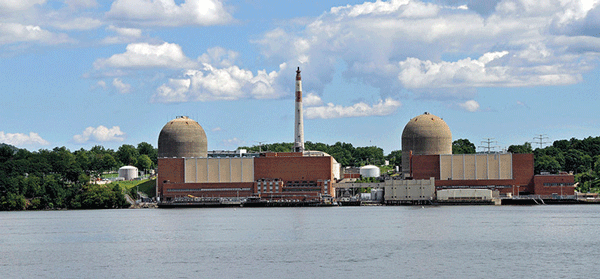
BY PAUL DERIENZO | Another troubling mishap at the Indian Point nuclear power plant last Saturday prompted a shutdown, or “trip,” of one of the two reactor units and the dispatch of inspectors from the U.S. Nuclear Regulatory Commission.
Governor Andrew Cuomo’s Office made the announcement that the reactor was “forced to shut down,” but New Orleans-based Entergy, which owns the plant, said there was no release of radiation or chemicals from the incident. The company said magnets holding control rods failed when power was lost, allowing the rods to sink into the reactor vessel, as designed, which shut down the nuclear reaction. Control rods are a feature of nuclear reactors that allow the nuclear reaction to be adjusted or shut down.
Coincidentally, N.R.C. Chairperson Stephen Burns was visiting the plant and the agency reported on Monday that the power loss was caused by a short-circuit in a roof fan.
Cuomo, who has called for closure of the 40-year-old plant, said that he had “directed the Department of Public Service to investigate and monitor the situation.”
The second of the two operating units at Indian Point was not affected and remains on line. Burns was met by a demonstration on Monday at a hotel in Tarrytown, N.Y., where he was holding meetings. The protesters are opposed to construction of a natural gas pipeline that will pass near the nuclear plant. The pipeline has been approved and construction will begin in March. Protesters say they fear a potential gas explosion might threaten the nuclear plant.
This is the second incident at Indian Point this year. In May, an electrical transformer exploded, releasing 3,000 gallons of oil into the Hudson River. The catastrophic failure ignited the oil, and black smoke billowing from the fire was visible for miles. A report by the N.R.C. released earlier this month said that the transformer fire itself was never a threat, but the subsequent flooding of an electrical switching room may have caused a loss of power to the reactor.
A little known fact of nuclear reactors is that they must always be connected to a power source independent of the reactor itself. The outside power allows the reactor to be controlled even if it has to be shut down. Although Indian Point was never in danger of a meltdown, a loss of outside power has been implicated in some of the worst nuclear disasters, such as at Fukushima, where a tsunami flooded the electrical system, and Chernobyl, where outside electricity was purposely cut off as part of an experiment that quickly raged out of control.
A meltdown happens when a reactor core becomes so hot from a loss of cooling water that the fuel elements melt into a radioactive blob. A partial meltdown at Three Mile Island in 1979 sparked the anti-nuclear movement and made it much more difficult to build nuclear reactors in the U.S.
According to the N.R.C. report on the May incident, when sensors detected a rise in temperature caused by the fire, large “deluge valves” were triggered, flooding the area with water to put out the fire. The water began to rise, flowing under a door and flooding the “switchgear” room, where it pooled on the floor.
Sensors designed to shut off the valves, as well as a drain in the room and storm drains outside the building, were discovered to be partially obstructed by debris. The rising water threatened the electrical equipment involved with transmitting power from off-site to the nuclear plant. According to the Union of Concerned Scientists, if the water had risen a few more inches, it could have caused a “blackout condition” at the plant.
Problems with drains at Indian Point should have not taken its operators by surprise, as happened last weekend, says the U.C.S. A report by the N.R.C. in 2012 had issued a “green” alert, meaning that there is a problem, but not especially serious, with a blocked drain. According to the U.C.S., the drain was subsequently tested but in a non-rigorous manner that failed to isolate the problem, which was discovered after the transformer fire.
The U.C.S. said that flooding problems have been a problem at numerous reactors but are often considered low priority by the N.R.C. In 1994, Entergy admitted that potential flooding caused by water pipes breaking in an earthquake was a significant possible problem at Indian Point. The N.R.C. didn’t require plant operators to make changes and nothing was done by Entergy to address its own findings.
The four-decade-old reactors at Indian Point are under review for relicensing by the N.R.C. Entergy is requesting a 20-year license extension. There are currently 99 operating commercial nuclear power reactors in America. About 30 percent of New York State’s electricity is generated by nuclear plants. Governor Cuomo has come out in support of closing down Indian Point because he says it’s too close to the city. Entergy recently announced it was closing its money-losing Fitzpatrick nuclear generating station in Upstate Oswego. However, Cuomo wants to keep that plant operating, which has sparked a bitter dispute, since Indian Point is a profitable enterprise.
Throughout the country, most of the aging fleet of nuclear reactors have quietly had their licenses extended, some for up to 80 years, longer than an average human lifespan. The biggest problem with these reactors has been disposal of their waste. Federal law requires commercial plants to keep spent fuel stored on-site in pools of water or specially designed dry casks. Approval for use of an underground dump already built near Las Vegas has been blocked in Congress, and currently several private dumps have been vying for the right to temporarily store highly radioactive commercial waste until a permanent repository gets the O.K.
Although nuclear reactors are touted as “carbon free” and therefore not contributing to global warming, that doesn’t take into account the fact that mining and processing of uranium, construction of plants and waste disposal actually produce large amounts of carbon, as well as the dangers of radiation releases or accidents.
The original 40-year license for Indian Point Unit 2 expired in September 2013 and the license for Unit 3 is set to expire Sun., Dec. 13. Entergy is allowed to keep operating the reactors until N.R.C. decides on the renewal application.

































